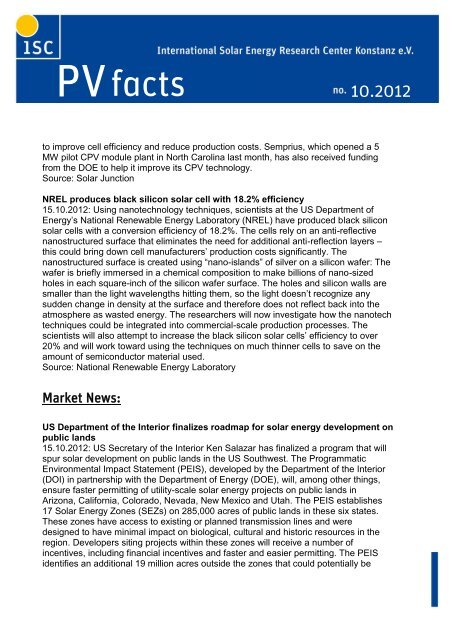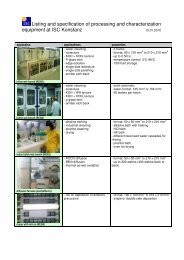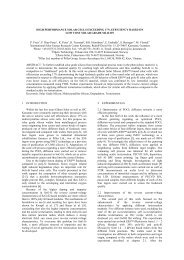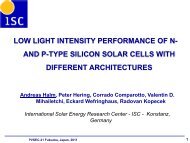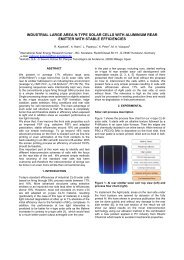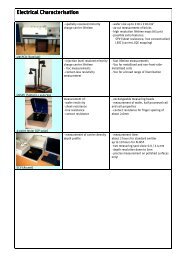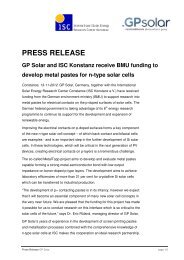PVfacts from 10.2012 - ISC Konstanz
PVfacts from 10.2012 - ISC Konstanz
PVfacts from 10.2012 - ISC Konstanz
You also want an ePaper? Increase the reach of your titles
YUMPU automatically turns print PDFs into web optimized ePapers that Google loves.
<strong>PVfacts</strong> no. 01.2012 | »research, development & expansion«<br />
PV<br />
facts<br />
<strong>10.2012</strong><br />
to improve cell efficiency and reduce production costs. Semprius, which opened a 5<br />
MW pilot CPV module plant in North Carolina last month, has also received funding<br />
<strong>from</strong> the DOE to help it improve its CPV technology.<br />
Source: Solar Junction<br />
NREL produces black silicon solar cell with 18.2% efficiency<br />
15.<strong>10.2012</strong>: Using nanotechnology techniques, scientists at the US Department of<br />
Energy’s National Renewable Energy Laboratory (NREL) have produced black silicon<br />
solar cells with a conversion efficiency of 18.2%. The cells rely on an anti-reflective<br />
nanostructured surface that eliminates the need for additional anti-reflection layers –<br />
this could bring down cell manufacturers’ production costs significantly. The<br />
nanostructured surface is created using “nano-islands” of silver on a silicon wafer: The<br />
wafer is briefly immersed in a chemical composition to make billions of nano-sized<br />
holes in each square-inch of the silicon wafer surface. The holes and silicon walls are<br />
smaller than the light wavelengths hitting them, so the light doesn’t recognize any<br />
sudden change in density at the surface and therefore does not reflect back into the<br />
atmosphere as wasted energy. The researchers will now investigate how the nanotech<br />
techniques could be integrated into commercial-scale production processes. The<br />
scientists will also attempt to increase the black silicon solar cells’ efficiency to over<br />
20% and will work toward using the techniques on much thinner cells to save on the<br />
amount of semiconductor material used.<br />
Source: National Renewable Energy Laboratory<br />
Market News:<br />
US Department of the Interior finalizes roadmap for solar energy development on<br />
public lands<br />
15.<strong>10.2012</strong>: US Secretary of the Interior Ken Salazar has finalized a program that will<br />
spur solar development on public lands in the US Southwest. The Programmatic<br />
Environmental Impact Statement (PEIS), developed by the Department of the Interior<br />
(DOI) in partnership with the Department of Energy (DOE), will, among other things,<br />
ensure faster permitting of utility-scale solar energy projects on public lands in<br />
Arizona, California, Colorado, Nevada, New Mexico and Utah. The PEIS establishes<br />
17 Solar Energy Zones (SEZs) on 285,000 acres of public lands in these six states.<br />
These zones have access to existing or planned transmission lines and were<br />
designed to have minimal impact on biological, cultural and historic resources in the<br />
region. Developers siting projects within these zones will receive a number of<br />
incentives, including financial incentives and faster and easier permitting. The PEIS<br />
identifies an additional 19 million acres outside the zones that could potentially be


